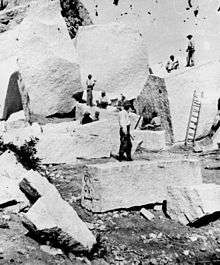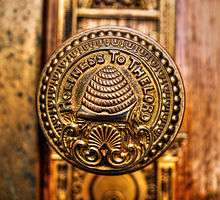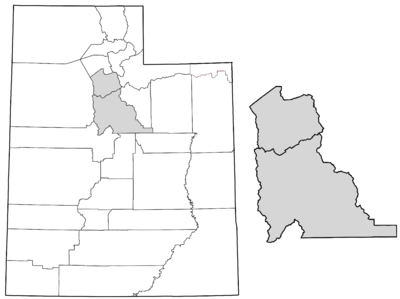Salt Lake Temple
| Salt Lake Temple | ||||||||||||||||||||||||||||||||||||||||||||
|---|---|---|---|---|---|---|---|---|---|---|---|---|---|---|---|---|---|---|---|---|---|---|---|---|---|---|---|---|---|---|---|---|---|---|---|---|---|---|---|---|---|---|---|---|
 Salt Lake Temple is the centerpiece of the 10-acre (4.0 ha) Temple Square in Salt Lake City, Utah. | ||||||||||||||||||||||||||||||||||||||||||||
| Number | 4 | |||||||||||||||||||||||||||||||||||||||||||
| Dedication | 6 April 1893 by Wilford Woodruff | |||||||||||||||||||||||||||||||||||||||||||
| Site | 10 acres (4 hectares) | |||||||||||||||||||||||||||||||||||||||||||
| Floor area | 253,015 sq ft (23,506 m2) | |||||||||||||||||||||||||||||||||||||||||||
| Height | 222 ft (68 m) | |||||||||||||||||||||||||||||||||||||||||||
| Preceded by | Manti Utah Temple | |||||||||||||||||||||||||||||||||||||||||||
| Followed by | Laie Hawaii Temple | |||||||||||||||||||||||||||||||||||||||||||
| Official website • News & images | ||||||||||||||||||||||||||||||||||||||||||||
| ||||||||||||||||||||||||||||||||||||||||||||
Coordinates: 40°46′13.68480″N 111°53′31.04880″W / 40.7704680000°N 111.8919580000°W The Salt Lake Temple is a temple of The Church of Jesus Christ of Latter-day Saints (LDS Church) located on Temple Square in Salt Lake City, Utah, United States. At 253,015 square feet (23,505.9 m2), it is the largest LDS temple by floor area. Dedicated in 1893, it is the sixth temple completed by the church, requiring 40 years to complete, and the fourth temple built since the Mormon exodus from Nauvoo, Illinois, in 1846.[1]
Details

The Salt Lake Temple is the centerpiece of the 10-acre (4.0 ha) Temple Square in Salt Lake City, Utah. Like other LDS temples, it is considered sacred by the church and its members and a temple recommend is required to enter, so there are no public tours inside the temple as there are for other adjacent buildings on Temple Square. In 1912, the first public photographs of the interior were published in the book The House of the Lord, by James E. Talmage.[2] Since then, various photographs have been published, including by Life magazine in 1938.[3] The temple grounds are open to the public and are a popular tourist attraction.[4] Due to its location at LDS Church headquarters and its historical significance, the Temple is patronized by Latter-day Saints from many parts of the world. The Salt Lake Temple is also the location of the weekly meetings of the First Presidency and the Quorum of the Twelve Apostles.[5][3] As such, there are special meeting rooms in the building for these purposes, including the Holy of Holies, which are not present in other temples.
The official name of the Salt Lake Temple is also unique. In 1999, as the building of LDS temples accelerated, the church announced a formal naming convention for all existing and future temples. For temples located in the United States and Canada, the name of the temple is generally the city or town in which the temple is located, followed by the name of the applicable state or province (with no comma). For temples outside of the U.S. and Canada, the name of the temple is generally the city name (as above) followed by the name of the country. However, for reasons on which the church did not elaborate, the Salt Lake Temple was made an exception to the new guidelines and was not renamed the "Salt Lake City Utah Temple".[6] (The Provo City Center Temple is the only other temple that does not include a state, province, or country in the temple's name.)[7]
The temple also includes some elements thought to evoke Solomon's Temple at Jerusalem. It is oriented towards Jerusalem and the large basin used as a baptismal font is mounted on the backs of twelve oxen, as was the Molten Sea in Solomon's Temple (see Chronicles 4:2–4). (However, the literal interpretation of the Biblical verses has been disputed.)[8] At the east end of the building, the height of the center pinnacle to the base of the angel Moroni is 210 feet,[9] or 120 cubits,[10] making this Temple 20 cubits taller than the Temple of Solomon.[11]
The temple is located in downtown Salt Lake City, with several mountain peaks close by. Nearby, a shallow stream, City Creek, splits and flows both to the west and to the south, flowing into the Jordan River. There is a wall around the 10-acre (4.0 ha) temple site. The surrounding wall became the first permanent structure on what has become known as Temple Square. The wall is a uniform 15 feet high but varies in appearance because of the southwest slope of the site.[12]
Temple construction and dedication

The location for the temple was first marked by Mormon prophet Brigham Young, the second president of the church, on July 28, 1847, just four days after arriving in the Salt Lake Valley. The temple site was dedicated on February 14, 1853 by Heber C. Kimball. Groundbreaking ceremonies were presided over by Young, who laid the cornerstone on April 6 of that year.[13] The architect was Truman O. Angell, and the temple is said to feature both Gothic and Romanesque elements.[14]
Sandstone was originally used for the foundation. During the Utah War, the foundation was buried and the lot made to look like a plowed field to prevent unwanted attention from federal troops. After tensions had eased in 1858 and work on the temple resumed, it was discovered that many of the foundation stones had cracked, making them unsuitable for use. Although not all of the sandstone was replaced, the inadequate sandstone was replaced. The walls are quartz monzonite (which has the appearance of granite) from Little Cottonwood Canyon, located twenty miles (32 km) southeast of the temple site. Oxen transported the quarried rock initially, but as the Transcontinental Railroad neared completion in 1869 the remaining stones were carried by rail at a much faster rate.[13]
The capstone—the granite sphere that holds the statue of the Angel Moroni—was laid on April 6, 1892, by means of an electric motor and switch operated by Wilford Woodruff, the church's fourth president, thus completing work on the temple's exterior. The Angel Moroni statue, standing 12.5 feet (3.8 m) tall, was placed on top of the capstone later the same day.[15] At the capstone ceremony it was proposed by Woodruff that the interior of the building be finished within one year, thus allowing the temple to be dedicated forty years to the day of its commencement. John R. Winder was instrumental in overseeing the completion of the interior on schedule; he would serve as a member of the temple presidency until his death in 1910. Woodruff dedicated the temple on April 6, 1893, exactly forty years after the cornerstone was laid.[13]
Symbolism


The Salt Lake Temple incorporates many symbolic adornments, similar to other LDS temples around the world. Symbolism is an important subject in the LDS faith.[16]
The golden Angel Moroni placed on the capstone of the temple symbolizes the angel mentioned in Revelation 14:6 that will come to welcome in the Second Coming of Christ. The six spires of the temple represent the power of the priesthood. The three spires on the east side are a little higher than those on the west: they represent the Melchizedek, or "higher priesthood", and the Aaronic, or "preparatory priesthood" respectively. The three spires on the east side represent the church's First Presidency and the twelve smaller spires on those three represent the Twelve Apostles. On the west side of the temple the Big Dipper appears, which represents how the constellation was used to help travelers find the North Star and help them on their way,[17] in the same way the temple is viewed as a symbol to help people find their way back to heaven. On the east side of the temple are "clouds raining down" representing the way God has continued revelation and still speaks to man "like the rains out of Heaven". Above each door appears the "hand clasp," which is a representation of covenants that are made within temples. Around the temple there are several carved stones known as "sunstones" which represent heaven, "moonstones" in different phases representing this life in its different phases, and "starstones" representing Jesus Christ. The center tower on each side contains a depiction of the All-Seeing Eye of God representing how God sees all things.[1]
1962 temple bombing
On November 14, 1962, at about 1:30 AM, the southeast door of the Salt Lake Temple was bombed.[18][19] FBI agents state that the explosive had been wrapped around the door handles on the southeast entrance of the temple.[18] The large wooden entrance doors were damaged by flying fragments of metal and glass. Damage to interior walls occurred 25 feet inside the temple, but damage to the interior was minor.[18] Eleven exterior windows were shattered.[18] Many members of the LDS Church believed this incident was related to violence of the nation's racial strife[19] and the Priesthood racial restriction policy of the church at the time.
Temple presidents

- Lorenzo Snow, 1893–98
- Joseph F. Smith, 1898–1911
- Anthon H. Lund, 1911–21
- George F. Richards, 1921–38
- Stephen L. Chipman, 1938–45
- Joseph Fielding Smith, 1945–49
- Robert D. Young, 1949–53
- ElRay L. Christiansen, 1953–61
- Willard E. Smith, 1961–64
- Howard S. McDonald, 1964–68
- O. Leslie Stone, 1968–72
- John K. Edmunds, 1972–77
- A. Ray Curtis, 1977–82
- Marion D. Hanks, 1982–85
- Victor L. Brown, 1985–87
- Edgar M. Denny, 1987–90
- Spencer H. Osborn, 1990–93
- George I. Cannon, 1993–96
- Carlos E. Asay, 1996–99
- Derrill H. Richards, 1999
- W. Eugene Hansen, 1999–2002
- L. Aldin Porter, 2002–05
- M. Richard Walker, 2005–08
- Sheldon F. Child, 2008–11
- Oren Claron Alldredge Jr., 2011–14
- Cecil O. Samuelson, 2014–present
See also
- List of temples of The Church of Jesus Christ of Latter-day Saints
- List of temples of The Church of Jesus Christ of Latter-day Saints by geographic region
- Temple architecture (Latter-day Saints)
- The Church of Jesus Christ of Latter-day Saints in Utah
- The Mountain of the Lord
References
- 1 2 Satterfield, Rick, "Salt Lake Temple", Temples of The Church of Jesus Christ of Latter-day Saints, LDSChurchTemples.com, retrieved October 11, 2012
- ↑ Talmage, James. The House of the Lord. The Church of Jesus Christ of Latter Day Saints, 1912
- 1 2 "The Destiny of 747,000 Mormons is Shaped in These Hallowed Temple Rooms", Life, 4 (1): 22–23, January 3, 1938, retrieved October 11, 2012
- ↑ "Temple Square". Utah.com (Utah Office of Tourism). Retrieved October 11, 2012.
- ↑ Craven, Rulon G. (May 1991), "Prophets", Ensign, retrieved October 11, 2012
- ↑ "Temples renamed to uniform guidelines". Church News. Deseret News. October 16, 1999. Retrieved October 11, 2012.
- ↑ Walker, Joseph (March 23, 2012). "It's official: the Provo City Center Temple". Deseret News. Retrieved August 10, 2013.
- ↑ Hamblin, William J.; Seely, David Rolph (2007). Solomon's Temple: Myth and History. Thames & Hudson. pp. 191–193. ISBN 9780500251331.
- ↑ "Salt Lake Temple". ldschurchnewsarchive.com. Retrieved October 11, 2012.
- ↑ "What Was The True Origin Of The Biblical Cubit?". maranathachurchofgod.ca. Maranatha Church Of God (Barrie, Ontario, Canada). January 2011. Retrieved October 11, 2012.
- ↑ Clorfene, Chaim (February 2007), Ezra's Temple, Herod's Temple and Ezekiel's vision of the Third Temple (111), Jewishmag.com, retrieved October 11, 2012
- ↑ Hamilton 1992, p.
- 1 2 3 Hanks, Marion D. "Salt Lake Temple". LDS FAQ. BYU Studies. Retrieved October 11, 2012.
- ↑ Hawthorne, Christopher (February 14, 2002), Latter-Day Fortresses: The spooky charisma of Mormon temples, Slate.com, retrieved October 11, 2012
- ↑ "Temple capstone laid 100 years ago", Church News, April 4, 1992, retrieved October 11, 2012
- ↑ "Why Symbols?", Ensign, February 2007, retrieved October 11, 2012
- ↑ Truman O. Angell (17 August 1854), "The Temple: To the Editor of the Deseret News", Deseret News, Great Salt Lake City, Utah Territory, 4 (23), p. 2, retrieved 19 August 2014,
Moral, [of Ursa Major is that] the lost may find themselves by the Priesthood
- 1 2 3 4 "Blast Mormon Temple with Plastic Bomb". Chicago Daily Tribune. 15 November 1962. Retrieved 19 January 2015.
- 1 2 Johnson, Jeffrey O. (June 1994). "Change and Growth: The Mormon Church & the 1960sHE 1960" (PDF). Sunstone. Retrieved 19 January 2015.
Further reading
- Cannon, George Q. (1893), House of the Lord: Historical and Descriptive Sketch of the Salt Lake Temple from April 6, 1853 to April 6, 1893, Salt Lake City, Utah: Geo. Q. Cannon & Sons Co., OCLC 54243596
- Hamilton, Mark (1992). The Salt Lake Temple: A Monument to a People. Salt Lake City, Utah: University Services. ISBN 0-913535-07-9. OCLC 28119583.
- Hamilton, Charles Mark (1979). The Salt Lake Temple: an architectural monograph (Ph. D. thesis). Ohio State University. OCLC 5925170.
External links
 Media related to Salt Lake Temple at Wikimedia Commons
Media related to Salt Lake Temple at Wikimedia Commons- Official Salt Lake Temple page
- Inside The Salt Lake City Temple - a pictorial tour of the temple interior at Moroni10.com
- Historic American Buildings Survey (HABS) No. UT-2, "Salt Lake Temple, Temple Square, Salt Lake City, Salt Lake County, UT", 4 photos, 4 data pages, 1 photo caption page
